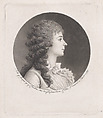Portrait of Madame Roland
Gilles Louis Chrétien French
After Jean Fouquet French
Not on view
In addition to hosting a salon that was an important meeting place for revolutionary politicians in Paris, Madame Roland played a powerful role behind the scenes by writing speeches and letters for her husband, Jean-Marie Roland de la Platière, who became minister of the interior in 1792. As a moderate Girondin, she opposed the violence of the more radical Jacobins and was arrested at the outset of the Terror, a period when thousands of perceived enemies of the Revolution were executed. Roland wrote her memoirs from prison before she was guillotined. During her lifetime, she sat for multiple physionotraces, a silhouette portrait technique invented by Chrétien.
Due to rights restrictions, this image cannot be enlarged, viewed at full screen, or downloaded.


